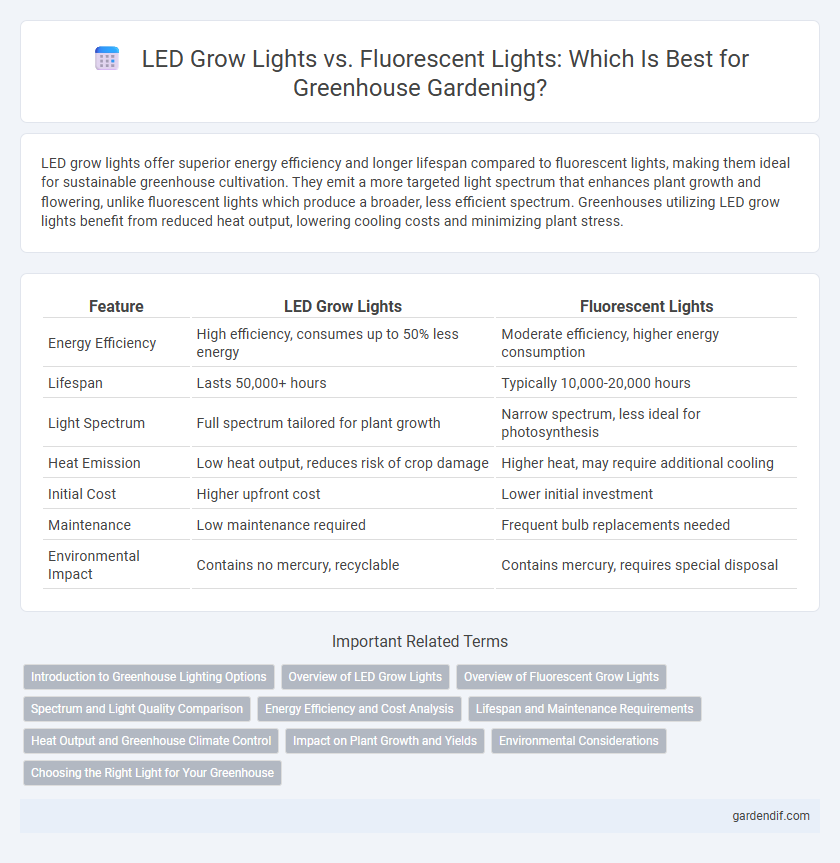
LED Grow Lights vs Fluorescent Lights Illustration
LED grow lights offer superior energy efficiency and longer lifespan compared to fluorescent lights, making them ideal for sustainable greenhouse cultivation. They emit a more targeted light spectrum that enhances plant growth and flowering, unlike fluorescent lights which produce a broader, less efficient spectrum. Greenhouses utilizing LED grow lights benefit from reduced heat output, lowering cooling costs and minimizing plant stress.
Table of Comparison
| Feature | LED Grow Lights | Fluorescent Lights |
|---|---|---|
| Energy Efficiency | High efficiency, consumes up to 50% less energy | Moderate efficiency, higher energy consumption |
| Lifespan | Lasts 50,000+ hours | Typically 10,000-20,000 hours |
| Light Spectrum | Full spectrum tailored for plant growth | Narrow spectrum, less ideal for photosynthesis |
| Heat Emission | Low heat output, reduces risk of crop damage | Higher heat, may require additional cooling |
| Initial Cost | Higher upfront cost | Lower initial investment |
| Maintenance | Low maintenance required | Frequent bulb replacements needed |
| Environmental Impact | Contains no mercury, recyclable | Contains mercury, requires special disposal |
Introduction to Greenhouse Lighting Options
LED grow lights offer superior energy efficiency and longer lifespan compared to fluorescent lights, making them a cost-effective solution for greenhouse cultivation. Fluorescent lights provide a broad light spectrum beneficial for seedling growth but consume more electricity and have a shorter operational life. Modern greenhouse lighting strategies often prioritize LED technology due to its customizable spectrum and reduced heat output, optimizing plant growth and minimizing energy costs.
Overview of LED Grow Lights
LED grow lights provide energy-efficient, full-spectrum lighting tailored for plant growth in greenhouses, delivering optimal wavelengths that enhance photosynthesis and yield. Their long lifespan, low heat emission, and customizable light spectrum make them superior to traditional fluorescent lights in promoting healthy plant development. Advanced LED technology supports precise control of light intensity and duration, resulting in improved growth cycles and reduced operational costs.
Overview of Fluorescent Grow Lights
Fluorescent grow lights emit a broad spectrum of light, primarily in the blue and green wavelengths, making them suitable for seedling growth and vegetative phases in greenhouses. These lights are energy-efficient, produce low heat, and have a longer lifespan compared to traditional incandescent bulbs, ensuring consistent plant development. Fluorescent fixtures, such as T5 and CFL bulbs, remain popular for small-scale greenhouse setups due to their affordability and effective light distribution.
Spectrum and Light Quality Comparison
LED grow lights offer a customizable spectrum tailored to specific plant growth stages, enhancing photosynthesis efficiency compared to the broader, less targeted spectrum of fluorescent lights. The superior light quality of LEDs includes higher PAR (Photosynthetically Active Radiation) output and consistent intensity, promoting healthier and faster plant development in greenhouse environments. Fluorescent lights emit a softer, more diffuse light but often lack the intensity and spectral precision required for optimal crop yields.
Energy Efficiency and Cost Analysis
LED grow lights offer significantly higher energy efficiency than fluorescent lights, consuming up to 50% less electricity while delivering equal or better light intensity for plant growth. The initial investment for LED systems is higher, but their longer lifespan and reduced energy consumption lead to lower operational costs and faster return on investment. Fluorescent lights incur higher ongoing energy expenses and require more frequent replacements, increasing the total cost of ownership in greenhouse applications.
Lifespan and Maintenance Requirements
LED grow lights offer a significantly longer lifespan, often exceeding 50,000 hours, compared to fluorescent lights, which typically last around 10,000 to 20,000 hours. Maintenance requirements for LED grow lights are minimal due to their durability and energy efficiency, whereas fluorescent lights demand more frequent replacements and careful handling of fragile tubes. This extended lifespan and reduced upkeep make LED grow lights a cost-effective and sustainable choice for greenhouse cultivation.
Heat Output and Greenhouse Climate Control
LED grow lights emit significantly less heat compared to fluorescent lights, enabling more precise temperature regulation within greenhouses. Lower heat output from LEDs reduces the risk of heat stress on plants and minimizes the need for extensive cooling systems. Efficient greenhouse climate control achieved through LED lighting promotes optimal plant growth and energy savings.
Impact on Plant Growth and Yields
LED grow lights provide a more tailored light spectrum that enhances photosynthesis efficiency, leading to faster plant growth and higher yields compared to fluorescent lights. Their energy intensity promotes better root development and flowering, which improves overall crop quality in greenhouse environments. Fluorescent lights, while cost-effective initially, often deliver less targeted light and lower energy output, resulting in slower growth rates and reduced harvest volumes.
Environmental Considerations
LED grow lights consume significantly less energy compared to fluorescent lights, reducing greenhouse gas emissions and lowering the carbon footprint of greenhouse operations. The longer lifespan of LEDs minimizes waste and the need for frequent replacements, resulting in less environmental impact from manufacturing and disposal. LEDs produce less heat, decreasing the demand for additional cooling systems and further conserving energy within controlled environment agriculture setups.
Choosing the Right Light for Your Greenhouse
LED grow lights offer higher energy efficiency, longer lifespan, and customizable light spectra that enhance plant growth compared to fluorescent lights. Fluorescent lights, while initially cheaper, emit less intense light and have shorter durability, making them less suitable for large-scale greenhouse operations. Selecting the right light depends on factors such as plant type, growth stage, energy costs, and desired yield, with LEDs generally providing superior performance and cost-effectiveness for greenhouse cultivation.
LED Grow Lights vs Fluorescent Lights Infographic

 gardendif.com
gardendif.com